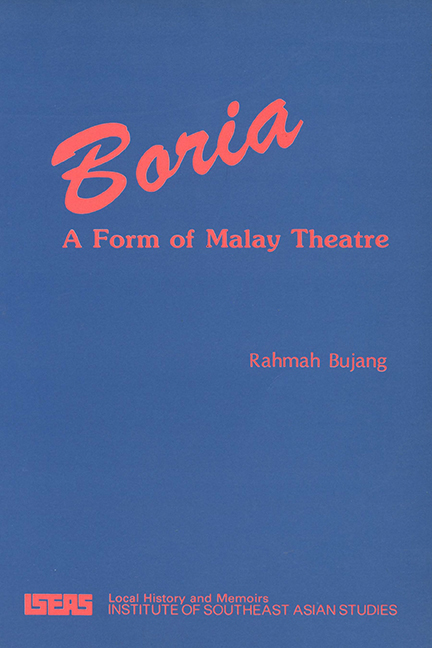2 - The Boria Show
Published online by Cambridge University Press: 21 October 2015
Summary
The Stage
A live show is generally played on an impromptu stage, usually a wooden platform two and a half to three feet above the ground. The person hiring the show is expected to have this platform ready for the troupe. An assembled stage would consist of a floor of wooden planks held together by nails and ropes, placed on empty oil drums or tree trunks at its four corners. Attached to the front corners of the stage are usually long strong poles for fixing electrical wires for the stage lighting and power for the band, if used. Without walls, the stage becomes an arena only for the musicians and players acting out a scene. Those on cue or due to exit make use of a rough ladder from the ground to the rear end of the stage. In most cases a simple shelter is built behind the stage with canvas or corrugated iron roofing and a few chairs are provided for the actors or performers to use when resting or changing. Stage lighting is basic and serves only to light the stage. Sometimes gas lighting is used instead of the more common electric lighting. The stage has no sets, the only props used being hand props. Audiences usually have to imagine, for example, the shape of doors and chairs which the actors refer to in the comic sketch. The rear of the stage is usually occupied by the troupe's band of musicians comprising a rhythm guitarist, lead guitarist, a drummer, an accordian player or a tambourine player. The front half would be the actors and performers' area during the show.
On state and national occasions and in competitions a proper stage in a hall is used, such as the Dewan Sri Pinang (City Hall) of Georgetown or the Dewan Pelbagai Guna (All- Purpose Hall) at Batu Uban. Even then there are no stage settings or props. On radio and television the genre is slightly altered to conform to certain technical needs.
- Type
- Chapter
- Information
- BoriaA Form of Malay Theatre, pp. 6 - 23Publisher: ISEAS–Yusof Ishak InstitutePrint publication year: 1987



